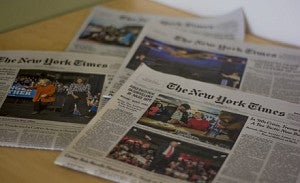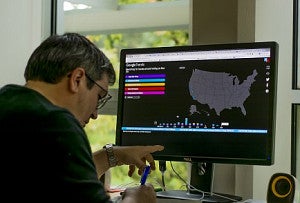Social Media May Be the Best Way for a Candidate to Reach Voters Who
Story past Andra Brichacek. Video by Ryan Lund and Aaron Nelson. Photos by Schaeffer Bonner and Karly DeWees.
Enquire Donald Trump and he'll tell yous journalists wield a lot of ability over the U.South. political process.
It's true that the media have played an of import office in politics since the Commencement Amendment established freedom of the printing equally a cornerstone of American democracy. Voters need information to brand educated decisions, and it's journalists' job to requite it to them.
Just can the media really alter the upshot of an election?
In addition to widespread voter fraud, which virtually experts agree would be incommunicable to accomplish, Trump is alleging the ballot has been "rigged" through biased media coverage. Contempo shifts in the media landscape have changed how the press interacts with candidates, campaigns and the voting public. And, at a time when trust in the media is at an all-fourth dimension depression, the fourth estate has come under burn from critics on both sides of the aisle for its coverage of the 2016 elections.
To find out what the research says about media's evolving office in the elections procedure, we talked to three scholars from the UO School of Journalism and Communication.
i. To cover or non to cover

The offset way journalists get involved in elections is by choosing which candidates to comprehend and how much. Those choices solitary can accept a huge effect on voter perceptions.
"As hard as it is to believe, the biggest thing that drives elections is uncomplicated name recognition," said Regina Lawrence, executive manager of the UO SOJC'due south Agora Journalism Heart and George S. Turnbull Portland Eye. "Inquiry has shown that some candidates tin be literally left invisible considering they tin can't win enough interest from the media."
Lawrence, a nationally recognized good on political communication and the co-writer of "Hillary Clinton'south Race for the White House: Gender Politics and the Media on the Campaign Trail" and "When the Press Fails: Political Power and the News Media from Iraq to Katrina," said this issue was most noticeable during the Republican primaries, when Trump generated an outsized proportion of the media coverage.
"He was able to get the equivalent of massive advertising buys without having to spend much money," Lawrence said.
For the media, this disproportionate coverage was driven more than by economics than political bias. In a competitive 24/vii news cycle, news organizations publish stories that volition drive traffic. And, thanks to his preexisting fame and ability to generate controversy, those stories were ofttimes about Trump.
Did all the gratis press make a divergence? Considering this twelvemonth's Republican primaries had such a large field, Trump's ability to stand out in the crowd probable played a significant function in his nomination.
2. Bias, scripts and the polarization of America
Research reveals that many major media outlets attract partisan audiences, which reflects political biases in their coverage. Again, this phenomenon is motivated by business organization: Since today's news consumers can get the basic facts from a quick internet search, many publications take differentiated themselves past shifting from straight news to context and assay

Unfortunately, the media'south growing political schisms seem to be driving polarization in the populace besides.
"Selective exposure is the trend many of the states take to seek out news sources that don't fundamentally challenge what we believe near the world," said Lawrence. "We know there'due south a relationship betwixt selective exposure and the growing divide in political attitudes in this state. And that gap is clearly related to the rising of more than partisan media sources."
Aside from ideological bias, according to Lawrence, journalists across outlets also perpetuate biased views past distilling circuitous campaigns and issues into simplified "scripts."
Ane popular election-coverage script is the "horserace" or "game frame" narrative. "We know from decades of enquiry that the mainstream media tend to run into elections through the prism of competition," said Lawrence. "Campaigns get covered a lot like sports events, with an emphasis on who'southward winning, who's losing, who'south up, who's downwardly, how they are moving ahead or behind in the polls."
The media also perpetuate character-based scripts. "For example, in 2000, the script for Al Gore was that he was a pompous bore, and the script for George Westward. Bush-league was that he wasn't very smart," said Lawrence.
In this twelvemonth's presidential race, the narratives that Clinton is a corrupt politician and Trump is a racist, misogynist outsider take dominated election coverage.
iii. Social media: Echo sleeping room and direct line to the masses
Co-ordinate to a recent Pew Inquiry Center study, 62 percent of Americans get their news via social media platforms. What they might not realize is that the news they meet is heavily filtered.
"What nosotros see on Facebook is dictated past algorithms that decide what you see based on what you like and dislike, what yous comment on and click on," said SOJC Assistant Professor Nicole Dahmen, who researches and blogs about visual communication and social media in politics. "Rather than getting a diversity of perspectives that contribute to political soapbox, we see an echo chamber."
On the other manus, social media gives users more directly admission to candidates than ever before. "With social media, voters may believe they have an intimate relationship with a candidate they will probably never meet in person," said Lawrence.
And candidates have unprecedented control over the images they nowadays. "Social media let candidates a direct means by which to communicate with the voting public, thereby bypassing the news media as a gatekeeper," Dahmen said.
4. A picture is worth one,000 words
For most people, visuals carry an even more powerful impact than words on a page.
"Visual communication inquiry has shown that images, especially of political candidates, convey emotions, actions, realism and credibility," said Dahmen. "These images grade a lasting impression in the listen of the voting public."
The photos news organizations choose to publish and such factors as their size and layout tin can also influence voter perceptions — and reveal possible bias.
"Look at how different newspapers beyond the land presented the story of the nomination of Hillary Clinton as the get-go female person candidate from a major political party," said Dahmen. "Some led with a dominant photograph of Hillary that positioned her in a favorable light. Some led with an image of her husband. And other newspapers led with an image of Donald Trump."
Published images besides become part of the permanent tape preserved on the internet. "Trump may claim he didn't mock a reporter with a disability," Dahmen said, "just nosotros have show in the form of a video and photographs showing that he did."
5. Information journalism: Fact-checking, polls and the self-perpetuating cycle

Once considered the to the lowest degree glamorous part of a announcer'due south chore, fact-checking has come into faddy with help from new tools that brand verification faster and more accurate.
"Organizations like PolitiFact and Factcheck.org are doing expert-quality journalism that isn't just post-obit the new, shiny story of the twenty-four hour period," Lawrence said. "They're asking tough questions nigh what candidates are proverb and testing them against the bachelor record. Only because of selective exposure, research suggests fact-checks will not necessarily change somebody's heed."
While fact-checkers focus attending on the candidates' stands on the issues, data analysis tools tin can perpetuate the media's heavy attention on the horserace.
"One of the nigh notable developments in the data journalism infinite are tools to make predictions about the outcomes of elections," said Damian Radcliffe, the SOJC's Carolyn S. Chambers Professor of Journalism and co-editor of "Information Journalism: Inside the Global Future." "The nearly prominent example of this is the work done by Nate Argent at FiveThirtyEight."
Much of the data Silver crunches come up from polls, ane of the nigh common topics of election coverage. "Polls influence voter perceptions," Lawrence said. "And nosotros know that how candidates are doing in the polls tin then influence the type of coverage they get."
The media flock to the forepart-runners. And the more coverage those candidates get, the higher they tend to climb in the polls — a dynamic that can plough into a cocky-perpetuating cycle.
6. Watchdogs of republic
Equally of this writing, the story of the 2016 elections is not yet consummate — and neither is the media's role in it.
"Given the claims Trump has been making virtually rigged elections, I look journalists to scout voting very carefully," said Lawrence. "Of course, that's a very large task with so many polling places beyond the country."
To face that challenge, ProPublica has launched Electionland to encompass "access to the ballot and problems that foreclose people from exercising their right to vote." The SOJC is one of xiii J-schools nationwide participating in the projection.
"Around 85 students accept volunteered to participate in a special newsroom on Election Day," said Radcliffe, faculty lead for Electionland. "Nosotros'll be monitoring social media to notice interesting stories of things happening across the West Coast. If we find issues people are talking nigh, we'll attempt to verify. And if necessary, we'll escalate them to the newsroom in New York to be explored in more detail."
At least ane thing hasn't inverse: Monitoring the workings of ability to evangelize the full story to the people is still the most of import part of the journalist's job description.
Andra Brichacek is the SOJC Communication team's writer and editor. She has most 20 years' experience creating content for impress and online media and has specialized in education since 2008. Follow her on Twitter @andramere.
Ryan Lund is a senior double-majoring in movie theater studies and journalism, with a minor in business concern administration. This is his beginning year as a digital content creator, with a specialization in videography and video editing, for the SOJC Communications office. He has also worked extensively with the Scientific discipline and Retentiveness project. Follow Ryan on Instagram and Twitter @RynoLund, and subscribe to his YouTube channel at NorthFern Productions.
Aaron Nelson is a senior studying journalism at the SOJC with a focus in photo and multimedia journalism. He currently works as a lensman for the Daily Emerald and has freelanced for KVAL. He has also held previous internships with Lookout Recruiting and the music-review website Daily-Vanquish.
Schaeffer Bonner is a graduate student in the SOJC's Multimedia Journalism Chief's plan at the SOJC in Portland. He previously worked six years every bit a photojournalist for ABC affiliate KAKE-ten in Wichita, Kansas. His coverage of breaking news has also been featured on ABC NewsOne and World News Now. Schaeffer is a veteran of the Us Air Force.
Karly DeWees is a design intern for the SOJC Communications office. She will exist graduating in Dec 2016 with honors and moving to Los Angeles to pursue a career in advertisement. During her time in the SOJC, she honed her photography skills shooting macro photos in Alaska for the Science and Memory project and local sports games for KVAL.com. You tin can view her piece of work at karlydewees.com.
0 Response to "Social Media May Be the Best Way for a Candidate to Reach Voters Who"
Post a Comment